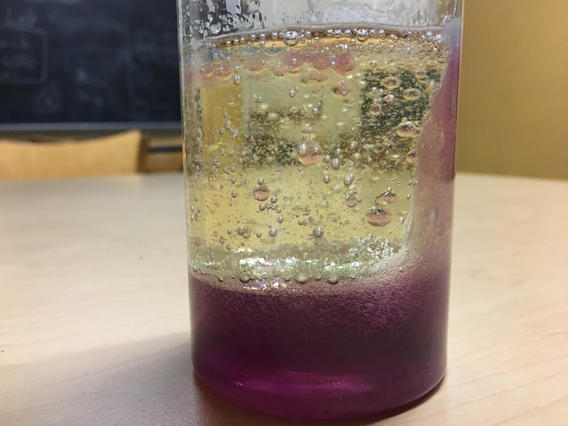Experiment Leaders: Daniel Krajovic and Maya Ramamurthy
Acids and bases are all around us, but we might not always notice them or appreciate how their chemistry improves our life. On November 18th, 2020, Ms. Michelle Ross’s 6th-8th grade astronomy class at Murray Middle school learned about some of the acids and bases in their everyday lives, how to identify them using chemistry knowledge, and what happens when they’re combined. The objective of this lesson was to teach students about the characteristics of acids and bases and allow them to combine this knowledge with what they know about liquid densities to create a lava lamp.
First, various examples of everyday acids and bases were presented, along with some examples of the role they play in real-world issues. Astronauts’ diets, for instance, have to balance pH in order to promote bone health, and ocean acidification drives coral reef decay in marine ecosystems. Then, the students reviewed their knowledge of protons, neutrons, and electrons and used this to understand the definitions of acids and bases, as well as their strength. The concept of a neutralization reaction, or acid-base reaction, was explained and used alongside the separation of oil and water by density to design a lava lamp driven by neutralization. The SfA members first demonstrated how this would be done. Food coloring was dissolved in water, and oil was poured on top of the water layer before an Alka-Seltzer tablet was dropped into the water, creating bubbles that rose and fell through the oil layer. Finally, the students were introduced to the concept of chemical equivalents. Acid-base reactions can only proceed as long as there’s acid AND base available, so if one runs out, then the reaction will stop even if there’s still some of the other around. The acid/base contents of lemon juice, vinegar, baking soda, and Alka-Seltzer tablets were described, and the students were asked to think about how the neutralization reactions might start or stop based on their use of the different chemicals in the lava lamps. The students then paired off, and each pair got to create a lava lamp and test their predictions.

Here is one of our DIY lava lamps in action!